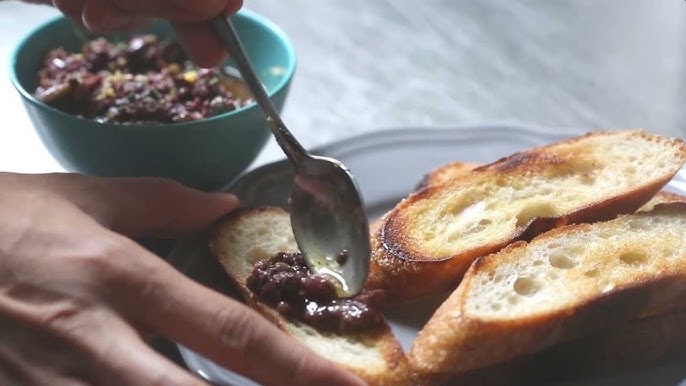Tapenade Recipe: Tapenade is a zesty, flavorful spread made primarily from olives, capers, and olive oil. It’s a staple in Mediterranean cuisine, particularly in Southern France, where it’s often served as an appetizer or condiment. With its rich, salty flavor and creamy texture, tapenade adds a punch of umami to just about anything—bread, crackers, sandwiches, or even pasta.
This delicious paste gets its name from “tapeno,” the Provençal word for capers, highlighting their starring role in the recipe. Unlike many condiments that are subtle and mild, tapenade is bold and deeply savory. If you’re a fan of Mediterranean flavors, this is one recipe you’ll want to add to your culinary repertoire.
Origins and Cultural Significance
Tapenade hails from Provence, a region in the south of France known for its sun-drenched landscapes, lavender fields, and olive groves. The dish has deep roots in Mediterranean cooking, with variations found in Italian and Greek cuisines too. While the classic version is centered around black olives and capers, other versions might include green olives, herbs, or sun-dried tomatoes.
Historically, tapenade was a way to preserve the flavors of the harvest—olives and capers blended with oil into a spreadable, storable form. Today, it’s still beloved for its robust flavor and versatility. Served at French apéritifs or as part of mezze platters, tapenade brings both tradition and taste to the table.
Essential Ingredients for Tapenade
Classic Ingredients
To make a traditional tapenade, you don’t need a long grocery list. Just a few high-quality ingredients come together to create a vibrant and flavorful spread:
- Black olives (like Kalamata or Niçoise, pitted)
- Capers (rinsed if packed in salt)
- Anchovy fillets (optional but authentic)
- Garlic cloves
- Fresh lemon juice
- Olive oil (extra virgin for best flavor)
- Fresh herbs (thyme or parsley, optional)
The quality of your olives and olive oil really makes a difference here. Choose olives that are firm and flavorful, and opt for cold-pressed extra virgin olive oil if possible. Anchovies provide a savory depth, but they can be omitted for a vegetarian version.
Variations You Can Try
Tapenade is endlessly customizable. Depending on your taste preferences and dietary needs, you can tweak the ingredients:
- Green olives for a brighter, slightly more bitter flavor.
- Sun-dried tomatoes to add sweetness and body.
- Roasted red peppers for a smoky twist.
- Chili flakes if you like it spicy.
- Walnuts or almonds for added texture and richness.
Whether you’re a traditionalist or like to experiment, tapenade is a canvas for creativity. The beauty of this recipe lies in its flexibility, so don’t be afraid to put your own spin on it.
Tools and Equipment You’ll Need
Kitchen Essentials
Making tapenade is blissfully simple when it comes to equipment. You probably have everything you need in your kitchen already:
- Food processor or blender – for blending the ingredients into a coarse or smooth paste
- Measuring spoons and cups – to get the proportions just right
- Cutting board and knife – for prepping your ingredients
- Mixing bowl – if you prefer mixing by hand for a chunkier texture
If you’re making tapenade the old-fashioned way, you could even use a mortar and pestle. It takes a little more elbow grease, but the texture is wonderfully rustic.
Optional but Helpful Tools
- Spatula – for scraping down the sides of the processor
- Glass jars or airtight containers – for storage
- Citrus juicer – for squeezing fresh lemon juice easily
These aren’t mandatory, but they do make the process smoother and more enjoyable, especially if you plan to make tapenade regularly.
Step-by-Step Tapenade Recipe
Step 1: Prepping the Ingredients
Start by prepping all your ingredients. Pit the olives if they aren’t already, rinse the capers, peel the garlic, and drain the anchovies. This is a quick step but essential for a smooth process.
For a basic tapenade, gather:
- 1 cup pitted black olives
- 2 tablespoons capers
- 2 anchovy fillets (optional)
- 1 garlic clove
- 2 tablespoons fresh lemon juice
- ¼ to ⅓ cup extra virgin olive oil
- Fresh herbs like thyme or parsley (optional)
If you’re using any variations like sun-dried tomatoes or roasted peppers, prep those too. Cut them into small chunks so they blend evenly.
Now that everything is ready, it’s time to blend up this Mediterranean magic.
Step 2: Blending to the Perfect Texture
Now comes the fun part—blending everything into a deliciously rich and savory paste. You can adjust the texture based on your preference. Some folks like it smooth and creamy, while others prefer a chunkier, more rustic consistency.
Start by adding the olives, capers, anchovies (if using), and garlic into your food processor or blender. Pulse a few times to break everything down a bit. Then slowly drizzle in the olive oil and lemon juice while continuing to blend. You’ll want to scrape down the sides of the processor once or twice to ensure everything is evenly incorporated.
If the mixture seems too thick, add a little more olive oil. For a bit more zing, splash in extra lemon juice. Once the tapenade reaches your desired consistency—either chunky or smooth—you’re good to go. Taste as you blend, and adjust seasoning if needed. Some people like to add a pinch of black pepper or a few fresh herbs at this point.
A pro tip? Don’t over-process. Tapenade is supposed to have some texture—it’s not a smoothie. Think spreadable, not pourable.
Step 3: Adjusting Flavors and Seasoning
At this stage, you’ve got your basic tapenade ready, but don’t stop just yet. Now’s the time to fine-tune those flavors. This step can take your tapenade from good to absolutely gourmet.
Take a spoonful and taste it. Ask yourself a few questions:
- Is it too salty? Add a bit more lemon juice or a touch of fresh herbs.
- Not salty enough? A tiny pinch of sea salt or an extra caper or two could do the trick.
- Too tangy? A splash more olive oil can mellow it out.
- Lacking punch? Add a dash more garlic or a third anchovy for that umami boost.
You can also stir in some chopped herbs like parsley or thyme for a fresh lift. Want a little kick? A pinch of chili flakes or a few drops of hot sauce can wake up the flavor. This is your moment to make the tapenade truly your own.
Once you’ve dialed in the perfect balance, transfer your tapenade to a serving bowl or jar. If you’re not eating it right away, it’s time to talk storage.
Step 4: Serving Suggestions
So, how do you serve this flavor-packed wonder? Tapenade is surprisingly versatile and pairs beautifully with a wide range of foods.
Here are some go-to ideas:
- As a spread: Slather it on crusty baguette slices, crackers, or pita chips for an instant appetizer.
- In sandwiches and wraps: Use it as a savory base layer in your favorite Mediterranean-inspired wrap.
- With cheese boards: A spoonful of tapenade adds contrast to soft cheeses like goat cheese or brie.
- Over grilled meats: Dollop it over grilled chicken, lamb chops, or fish for a gourmet touch.
- With pasta: Stir a spoonful into freshly cooked pasta with a bit of reserved pasta water and Parmesan.
- On pizza: Instead of traditional tomato sauce, try a thin layer of tapenade topped with cheese and roasted veggies.
It even makes a great filling for stuffed mushrooms or deviled eggs. The sky’s the limit when it comes to using tapenade creatively in the kitchen.
How to Store and Preserve Tapenade
Storage Tips
Tapenade keeps surprisingly well, thanks to its salty ingredients and oil base. Transfer your finished tapenade into an airtight container, preferably glass. Smooth the surface and pour a thin layer of olive oil over the top to seal it from air exposure. This not only helps preserve it but also maintains its vibrant flavor.
Store it in the refrigerator, where it will stay fresh for up to 2 weeks. Just remember to give it a good stir before serving, and always use a clean spoon to scoop some out to prevent contamination.
Freezing Tapenade
Need to store it even longer? You can freeze tapenade, although the texture might change slightly when thawed. For best results:
- Portion it into small containers or ice cube trays.
- Cover tightly or seal in freezer-safe bags.
- Freeze for up to 3 months.
When ready to use, thaw in the refrigerator overnight. Give it a stir and, if needed, refresh it with a little lemon juice or olive oil.
Creative Ways to Use Tapenade
As a Spread
One of the most classic—and delicious—ways to enjoy tapenade is as a spread. It’s the star of any charcuterie board and a conversation-starter at dinner parties. The rich, briny flavor of the olives and capers creates an irresistible contrast when paired with crunchy, toasted bread. Whether it’s a simple piece of baguette or gourmet crostini, a generous smear of tapenade elevates it to restaurant-quality fare.
You can also use tapenade as a sandwich spread. Replace mayonnaise or mustard with tapenade for a Mediterranean twist on your usual turkey or roast beef sandwich. It’s particularly good in vegetarian sandwiches, where it adds that umami flavor many veggie sandwiches lack. Try it with roasted vegetables and goat cheese on ciabatta—it’s divine.
For breakfast, mix a spoonful of tapenade into your avocado toast or alongside scrambled eggs. You can even use it as a layer in bruschetta or pair it with hummus on a mezze platter. Its versatility is endless when used as a spread.
As a Topping or Ingredient
Tapenade’s utility doesn’t stop at being a spread. It’s also a fantastic topping and ingredient in various cooked dishes. For starters, spoon it over grilled fish like salmon or cod to add a burst of flavor. The briny tapenade complements the rich, fatty flavor of fish beautifully. It’s also amazing atop grilled chicken, giving it that Mediterranean flair with zero effort.
You can stir tapenade into pasta dishes for an easy, elegant dinner. A spoonful mixed with warm pasta, some olive oil, and grated Parmesan cheese becomes a gourmet meal in under 10 minutes. Try it in cold pasta salads too—it adds punch without overpowering the other ingredients.
For pizza lovers, tapenade makes a brilliant base instead of tomato sauce. Spread it thinly on your dough, add cheese, roasted veggies, or even anchovies, and bake to golden perfection. It’s bold, different, and oh-so-delicious.
Another lesser-known but awesome use is in stuffed dishes. Think stuffed mushrooms or bell peppers with a tapenade and breadcrumb filling. It brings layers of savory depth that you just can’t get with standard fillings.
FAQs about Tapenade Recipe
Can I make tapenade without anchovies?
Yes, absolutely! While anchovies add depth and umami, you can skip them for a vegetarian version. Add a pinch of sea salt or a few more capers to enhance the saltiness and balance the flavor.
How long does tapenade last in the fridge?
Stored in an airtight container and topped with a layer of olive oil, tapenade can last up to 2 weeks in the fridge. Always use a clean spoon when serving to maintain freshness.
Can I use green olives instead of black?
Definitely. Green olives give tapenade a brighter, tangier flavor. Castelvetrano olives are a popular choice if you’re looking for something mild and buttery.
What wine pairs well with tapenade?
Tapenade pairs wonderfully with dry, crisp wines like Sauvignon Blanc or a light rosé. For red wine lovers, go for something earthy and not too tannic like Pinot Noir.
Is tapenade keto-friendly?
Yes! Tapenade is low in carbs and high in healthy fats, making it a great choice for keto and low-carb diets. Just make sure your olives and capers don’t have added sugars.
Conclusion
Tapenade might sound fancy, but it’s surprisingly easy to make and even easier to fall in love with. This Mediterranean gem, with its bold flavors and creamy texture, is a must-try whether you’re a seasoned cook or just starting your culinary journey. From the sun-soaked fields of Provence to your own kitchen, tapenade brings a taste of the Mediterranean to every bite.
With just a handful of ingredients and a food processor, you can whip up a gourmet-worthy spread in minutes. Better yet, you can customize it endlessly—add herbs, switch olives, skip the anchovies, or spice it up. Whether you use it as a spread, a sauce, or a topping, tapenade brings flavor and flair to your meals with zero fuss.
Try it once, and you’ll be hooked. Tapenade is not just a recipe—it’s an experience, a cultural snapshot, and a delicious way to elevate everyday dishes.



